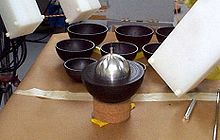
Back Neptunium Afrikaans ኔፕቲዩኒየም Amharic Neptunio AN नेप्चूनियम ANP نبتونيوم Arabic نيپتونيوم ARY نبتونيوم ARZ Neptuniu AST Neptunium Azerbaijani Нептуний Bashkir
 | |||||||||||||||||||||||||||||||||||||
| Neptunium | |||||||||||||||||||||||||||||||||||||
|---|---|---|---|---|---|---|---|---|---|---|---|---|---|---|---|---|---|---|---|---|---|---|---|---|---|---|---|---|---|---|---|---|---|---|---|---|---|
| Pronunciation | /nɛpˈtjuːniəm/ | ||||||||||||||||||||||||||||||||||||
| Appearance | silvery metallic | ||||||||||||||||||||||||||||||||||||
| Mass number | [237] | ||||||||||||||||||||||||||||||||||||
| Neptunium in the periodic table | |||||||||||||||||||||||||||||||||||||
| |||||||||||||||||||||||||||||||||||||
| Atomic number (Z) | 93 | ||||||||||||||||||||||||||||||||||||
| Group | f-block groups (no number) | ||||||||||||||||||||||||||||||||||||
| Period | period 7 | ||||||||||||||||||||||||||||||||||||
| Block | f-block | ||||||||||||||||||||||||||||||||||||
| Electron configuration | [Rn] 5f4 6d1 7s2 | ||||||||||||||||||||||||||||||||||||
| Electrons per shell | 2, 8, 18, 32, 22, 9, 2 | ||||||||||||||||||||||||||||||||||||
| Physical properties | |||||||||||||||||||||||||||||||||||||
| Phase at STP | solid | ||||||||||||||||||||||||||||||||||||
| Melting point | 912±3 K (639±3 °C, 1182±5 °F) | ||||||||||||||||||||||||||||||||||||
| Boiling point | 4447 K (4174 °C, 7545 °F) (extrapolated) | ||||||||||||||||||||||||||||||||||||
| Density (near r.t.) | alpha: 20.45 g/cm3[1] accepted standard value: 19.38 g/cm3 | ||||||||||||||||||||||||||||||||||||
| Heat of fusion | 5.19 kJ/mol | ||||||||||||||||||||||||||||||||||||
| Heat of vaporization | 336 kJ/mol | ||||||||||||||||||||||||||||||||||||
| Molar heat capacity | 29.46 J/(mol·K) | ||||||||||||||||||||||||||||||||||||
Vapor pressure
| |||||||||||||||||||||||||||||||||||||
| Atomic properties | |||||||||||||||||||||||||||||||||||||
| Oxidation states | +2, +3, +4,[2] +5, +6, +7 (an amphoteric oxide) | ||||||||||||||||||||||||||||||||||||
| Electronegativity | Pauling scale: 1.36 | ||||||||||||||||||||||||||||||||||||
| Ionization energies |
| ||||||||||||||||||||||||||||||||||||
| Atomic radius | empirical: 155 pm | ||||||||||||||||||||||||||||||||||||
| Covalent radius | 190±1 pm | ||||||||||||||||||||||||||||||||||||
| Other properties | |||||||||||||||||||||||||||||||||||||
| Natural occurrence | from decay | ||||||||||||||||||||||||||||||||||||
| Crystal structure | orthorhombic | ||||||||||||||||||||||||||||||||||||
| Thermal conductivity | 6.3 W/(m⋅K) | ||||||||||||||||||||||||||||||||||||
| Electrical resistivity | 1.220 µΩ⋅m (at 22 °C) | ||||||||||||||||||||||||||||||||||||
| Magnetic ordering | paramagnetic[3] | ||||||||||||||||||||||||||||||||||||
| CAS Number | 7439-99-8 | ||||||||||||||||||||||||||||||||||||
| History | |||||||||||||||||||||||||||||||||||||
| Naming | after planet Neptune, itself named after Roman god of the sea Neptune | ||||||||||||||||||||||||||||||||||||
| Discovery | Edwin McMillan and Philip H. Abelson (1940) | ||||||||||||||||||||||||||||||||||||
| Isotopes of neptunium | |||||||||||||||||||||||||||||||||||||
| |||||||||||||||||||||||||||||||||||||
Neptunium is a chemical element; it has symbol Np and atomic number 93. A radioactive actinide metal, neptunium is the first transuranic element. It is named after Neptune, the planet beyond Uranus in the Solar System, which uranium is named after. A neptunium atom has 93 protons and 93 electrons, of which seven are valence electrons. Neptunium metal is silvery and tarnishes when exposed to air. The element occurs in three allotropic forms and it normally exhibits five oxidation states, ranging from +3 to +7. Like all actinides, it is radioactive, poisonous, pyrophoric, and capable of accumulating in bones, which makes the handling of neptunium dangerous.
Although many false claims of its discovery were made over the years, the element was first synthesized by Edwin McMillan and Philip H. Abelson at the Berkeley Radiation Laboratory in 1940.[5] Since then, most neptunium has been and still is produced by neutron irradiation of uranium in nuclear reactors. The vast majority is generated as a by-product in conventional nuclear power reactors. While neptunium itself has no commercial uses at present, it is used as a precursor for the formation of plutonium-238, which is in turn used in radioisotope thermal generators to provide electricity for spacecraft. Neptunium has also been used in detectors of high-energy neutrons.
The longest-lived isotope of neptunium, neptunium-237, is a by-product of nuclear reactors and plutonium production. This isotope, and the isotope neptunium-239, are also found in trace amounts in uranium ores due to neutron capture reactions and beta decay.[6]
- ^ Sanchez, Rene G.; Loaiza, David J.; Kimpland, Robert H.; Hayes, David K.; Cappiello, Charlene C.; Myers, William L.; Jaegers, Peter J.; Clement, Steven D.; Butterfield, Kenneth B. "Criticality of a 237Np Sphere" (PDF). Japanese Atomic Energy Agency. Retrieved 2014-08-06.
- ^ Np(II), (III) and (IV) have been observed, see Dutkiewicz, Michał S.; Apostolidis, Christos; Walter, Olaf; Arnold, Polly L (2017). "Reduction chemistry of neptunium cyclopentadienide complexes: from structure to understanding". Chem. Sci. 8 (4): 2553–2561. doi:10.1039/C7SC00034K. PMC 5431675. PMID 28553487.
- ^ Magnetic susceptibility of the elements and inorganic compounds, in Handbook of Chemistry and Physics 81st edition, CRC press.
- ^ Kondev, F. G.; Wang, M.; Huang, W. J.; Naimi, S.; Audi, G. (2021). "The NUBASE2020 evaluation of nuclear properties" (PDF). Chinese Physics C. 45 (3): 030001. doi:10.1088/1674-1137/abddae.
- ^ McMillan, Edwin; Abelson, Philip Hauge (1940-06-15). "Radioactive Element 93". Physical Review. 57 (12): 1185–1186. Bibcode:1940PhRv...57.1185M. doi:10.1103/PhysRev.57.1185.2.
- ^ C. R. Hammond (2004). The Elements, in Handbook of Chemistry and Physics (81st ed.). CRC press. ISBN 978-0-8493-0485-9.
© MMXXIII Rich X Search. We shall prevail. All rights reserved. Rich X Search

